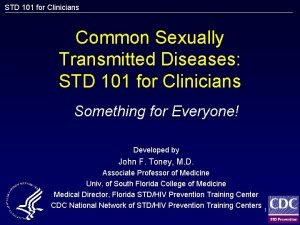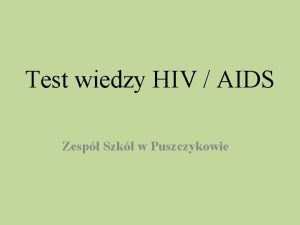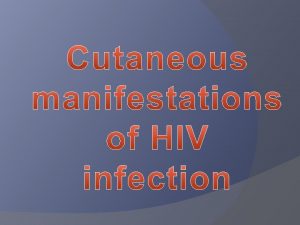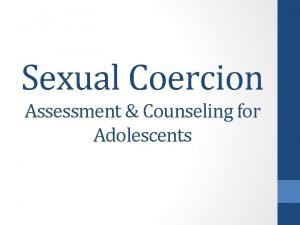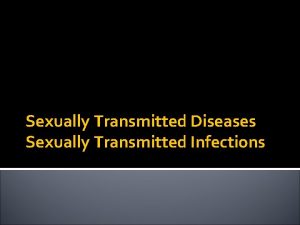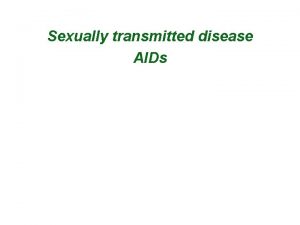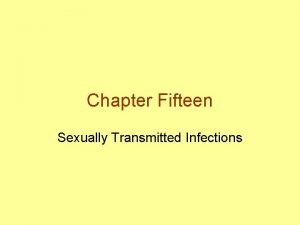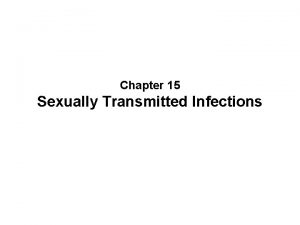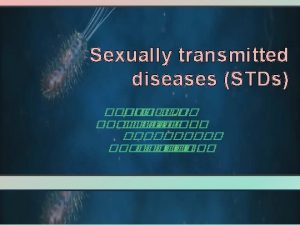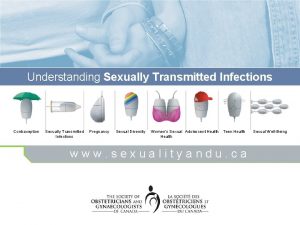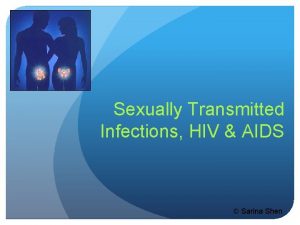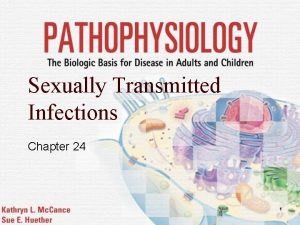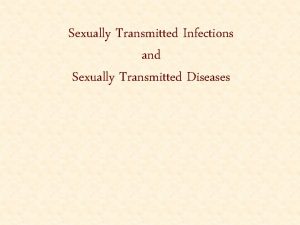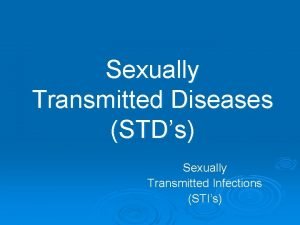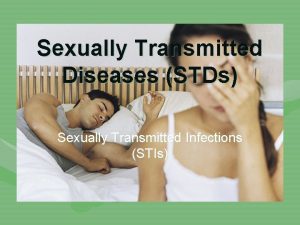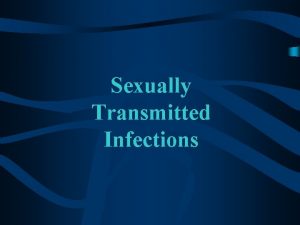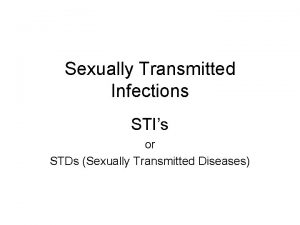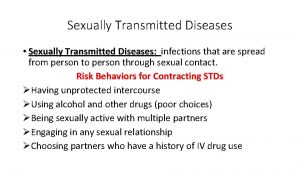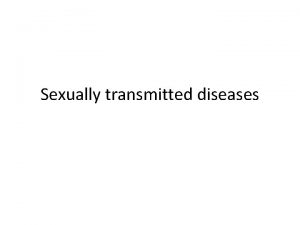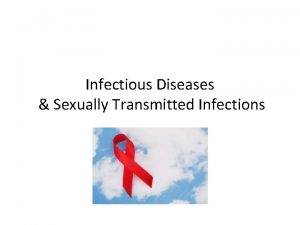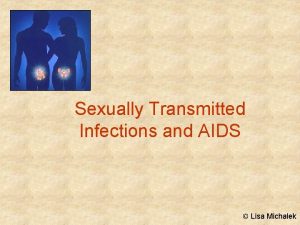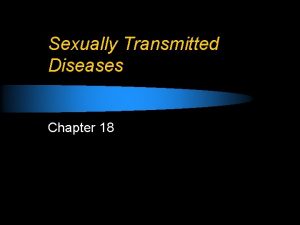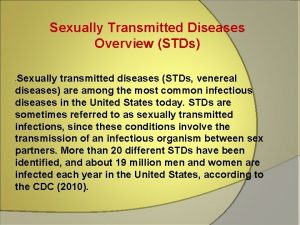Chapter 25 Sexually Transmitted Infections and HIV AIDS
































- Slides: 32

Chapter 25 Sexually Transmitted Infections and HIV/ AIDS 1

Lesson 1 The Risk of STIs 2

STIs and STDs • Sexually Transmitted Diseases (STDs) – Also known as… • Sexually Transmitted Infections (STIs) – Infectious diseases spread from person to person through sexual contact 3

STDs: The Hidden Epidemic • Epidemics – Occurances of diseases in which many people in the same place at the same time are affected – Many people with STDs are asymptomatic – without symptoms • High-Risk Behavior and STDs – – Being sexually active with more than one person Engaging in unprotected sex Selecting high-risk partners Using alcohol and other drugs 4

The Consequences of STDs and Preventing STDs Through Abstinence • Some STDs are incurable • Abstinence – Direct cause and effect • Some STDs cause cancer – The deliberate decision to • Some STDs can cause avoid harmful behaviors, complications that affect including sexual activity the ability to reproduce before marriage and the use of tobacco, alcohol, • Some STDs can be and other drugs passed from an infected female to her child before, during or after birth 5

Lesson 2 Common STIs 6

Human Papillomavirus • HPV, is a virus that can cause genital warts or asymptomatic infection • Considered the most common STD in the U. S. • Most types of HPV are asymptomatic • Pap test and other medical examinations to detect changes associated with HPV • Almost all cases of cervical cancer are caused by certain types of HPV 7

Genital Warts • Are pink or reddish warts with cauliflower like tops that appear on the genitals, the vagina or the cervix, one to three months after infection from HPV • Highly contagious • Spread by any form of sexual contact • Complications of HPV and genital warts can result in cervical cancer and cancer of the penis 8

PID • Pelvic Inflammatory Disease • Caused by untreated chlamydia or gonorrhea in females • Can lead to reproductive damage by causing obstruction and scarring of the fallopian tubes, resulting in involuntary infertility 9

Chlamydia • A bacterial infection that affects the reproductive organs of both males and females • It is asymptomatic • When symptoms may be present females may have vaginal discharge, burning upon urination, or abdominal pain • Often goes untreated until serious complications occur • Can cause PID and lead to chronic pelvic pain or infertility 10

Genital Herpes • An STD caused by the herpes simplex virus • Two types of HSV: – Type 1 usually causes cold sores – Type 2 usually causes genital sores • Medication can relieve the symptoms, but cannot cure herpes infection • It is not true that the virus can only be spread when sore are present • Once infected, the virus remains in the body for life 11

Gonorrhea • A bacterial STD that usually affects mucous membranes • 50 percent of females have no symptoms • Those who do experience symptoms may have vaginal discharge and pain or burning upon urination • Can be treated with antibiotics • Can be reinfected • If untreated, lead to infertility • Spread to the bloodstream and cause permanent damage to the joints 12

Trichomoniasis • An STD caused by a microscopic protozoan that results in infections of the vagina, urethra, and bladder • Females may have no symptoms • Vaginitis – Inflammation of the vagina characterized by discharge, odor, irritation, and itching 13

Syphilis • An STD that attacks many parts of the body and is caused by a small bacterium called a spirochet • First sign is a painless reddish sore called a chancre • The sore will heal on its own, but if not treated it spreads through the blood to other parts of the body • Eventually the disease can damage internal organs 14

Seeking Treatment • Figure 25. 2 – Other common STDs • Only a health care professional can prescribe treatment • By law it is kept confidential • Social obligation to prevent the spread of infection 15

Lesson 3 HIV and AIDS 16

AIDS and HIV • AIDS – 1981 an outbreak of a rare form of skin cancer known as Kaposi’s sarcoma was reported – About a year later the CDC labeled the disease acquired immune deficiency syndrome (AIDS) – A disease in which the immune system of the patient is weakened • HIV – 1983 – A virus that attacks the immune system – Cause of AIDS – In 2000, AIDS was the fifth leading cause of death among adults from 25 to 44 17

Teens at Risk • Teens have one of the fastest growing rates of HIV infection • New AIDS cases are declining however there has been no decline in the number of diagnosed HIV infections among youth from 13 to 24 years old • HIV can be prevented through ABSTINENCE from sexual activity and from injecting drugs 18

HIV and the Human Body 1. 2. 3. 4. 5. HIV attaches to cell surface Virus core enters cell and goes to nucleus Virus makes a copy of its genetic material New virus assembles at cell surface New virus breaks away from host cell 19

HIV and the Human Body cont. , • Lymphocytes are white blood cells – – – Help your body fight pathogens Body has billions of them Produced in bone marrow and found in blood, lymph nodes, appendix, tonsils and adenoids HIV invades certain cells of the immune system, including T cells, which help other lymphoocytes identify and destroy pathogens The virus takes over the cells and cause them to produce new copies The new viruses infect other cells and the process repeats itself 20

HIV and the Human Body cont 2. , – As the number of viruses increase the number of T cells decrease and the immune system becomes less capable of preventing infection and cancer – Opportunistic infections – Infections that occur in individuals who do not have healthy immune systems – With a weakened immune system the infected individual suffers one illness after another – HIV infection is progressive – It destroys the cells of the immune system over many months or years – Being infected with HIV does not mean the person has AIDS – AIDS is the advanced stage of HIV 21

How HIV Is Transmitted • HIV organism lives inside cells and body fluids • It does not survive in air • A person is not at risk of HIV infection by working next to or being in the same classroom as a person who is infected • HIV can be transmitted from an infected person to an uninfected person only in certain ways – Blood, semen, vaginal secretion, and breast milk • Sexual intercourse • Sharing needles • Mother to baby 22

Lesson 4 Treatment for HIV and AIDS 23

Stages of HIV Infection • • Develops over the course of years Person is infectious to others IMMEDIATELY after contracting the virus Symptoms develop about 3 to 6 weeks after becoming infected – fever, rash, headaches, body aches & swollen glands Symptoms disappear within 1 to 4 weeks & person enters the ASYMPTOMATIC stage • • • A period of time in which a person with HIV has no symptoms 24

Stages of HIV Infection cont. , • No signs of illness may appear from a period of 6 months to 10 years or more 1. In the meantime, the virus continues to grow and continues to be transmitted if the person is sexually active 2. In the re-occurring SYMPTOMATIC stage, the person begins to have symptoms due to a severe drop in immune cells 3. Finally, the 3 rd stage is AIDS where more serious symptoms occur: severely damaged immune system, opportunistic infections, dementia and death 25

How is HIV Transmitted? 1. Through sexual intercourse and/or oral sex – – – Must be an exchange of bodily fluids Can also enter a partners bloodstream through tiny cuts in the body that come in contact with the HIV infected blood There is no proof that HIV has been transmitted through insect bites or kissing 2. By sharing needles – Injecting drugs with contaminated needles directly into the bloodstream, under skin or into muscle 3. Through a blood transfusion 26

Your Breast Health 27

Simple Ways to Lower Your Risk, cont. , • Controllable – – High fat diet Exercise Alcohol Smoking • Uncontrollable – Growing up on a high fat diet – Family history – Aging – Age at first menstruation – Late menopause – Age at birth of first child/having no children – Gender – Environment 28

Early Detection Saves Lives • Three methods for early detection – Mammography – Clinical Breast Examination – Breast Self Exam (BSE) 29

Mammography • Baseline at 35, annually at 40 • Most effective screening test for detecting breast cancer early • X-rays of the breast and can detect lumps much smaller than the size of a pea • Every six months 30

Clinical Breast Exam (CSE) • Annually beginning at 18 • Trained clinician can help detect changes • Make sure your clinician exams you sitting up and laying down, and examines all of your breast tissue 31

Breast Self Exam (BSE) • Begin approximately at the age of 18 • Perform once a month at the END of your period so your breasts are less sensitive and your exam will be more comfortable • Lay on a flat, comfortable surface and with fry hands • Stand up in front of a mirror and look for changes in color, size and shape 32
 Chapter 25 sexually transmitted infections and hiv/aids
Chapter 25 sexually transmitted infections and hiv/aids Chapter 24 sexually transmitted diseases and hiv/aids
Chapter 24 sexually transmitted diseases and hiv/aids Chapter 24 lesson 1 sexually transmitted diseases
Chapter 24 lesson 1 sexually transmitted diseases Std
Std Nursing management of reproductive tract infection
Nursing management of reproductive tract infection Std
Std Name the five lesions associated with hiv/aids chapter 17
Name the five lesions associated with hiv/aids chapter 17 Test wiedzy o hiv i aids z odpowiedziami
Test wiedzy o hiv i aids z odpowiedziami Causative organism of hiv/aids
Causative organism of hiv/aids Kasus hiv aids
Kasus hiv aids Johnson and johnson botnet infections
Johnson and johnson botnet infections Bone and joint infections
Bone and joint infections Methotrexate yeast infection
Methotrexate yeast infection Retroviruses and opportunistic infections
Retroviruses and opportunistic infections Spongia officinalis
Spongia officinalis Opportunistic infections
Opportunistic infections Opportunistic infections
Opportunistic infections Storch infections
Storch infections Storch infections
Storch infections Neurosiphyllis
Neurosiphyllis Eye infections
Eye infections Postpartum infections
Postpartum infections Genital infections
Genital infections Amber blumling
Amber blumling Cell lysis complement system
Cell lysis complement system Acute gingival infections
Acute gingival infections Whale phylum
Whale phylum Segmentation of nematoda
Segmentation of nematoda Spider phylum
Spider phylum What is sexually dimorphic mean
What is sexually dimorphic mean What is coercion
What is coercion Protista reproduction
Protista reproduction Was it sexual abuse quiz
Was it sexual abuse quiz





